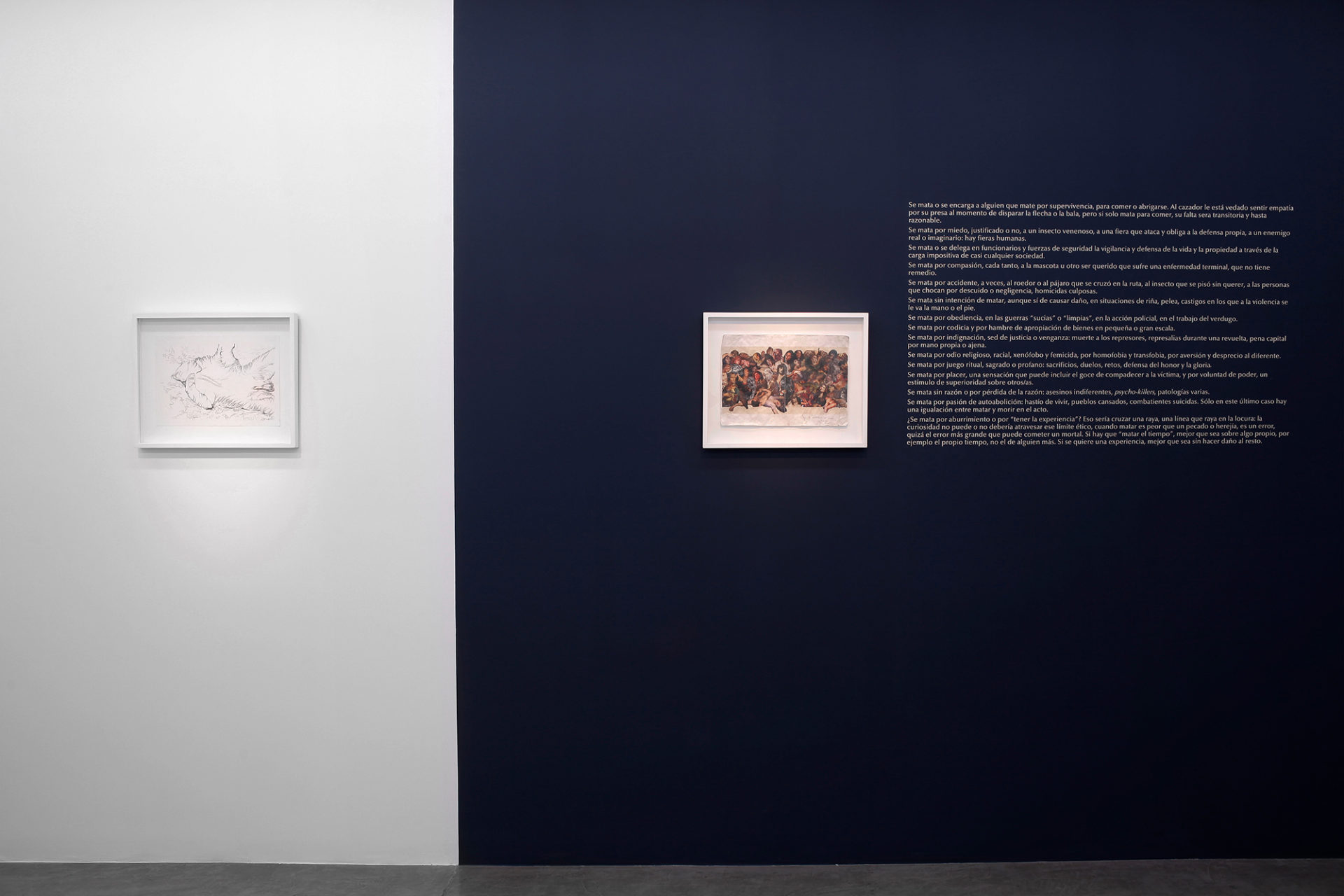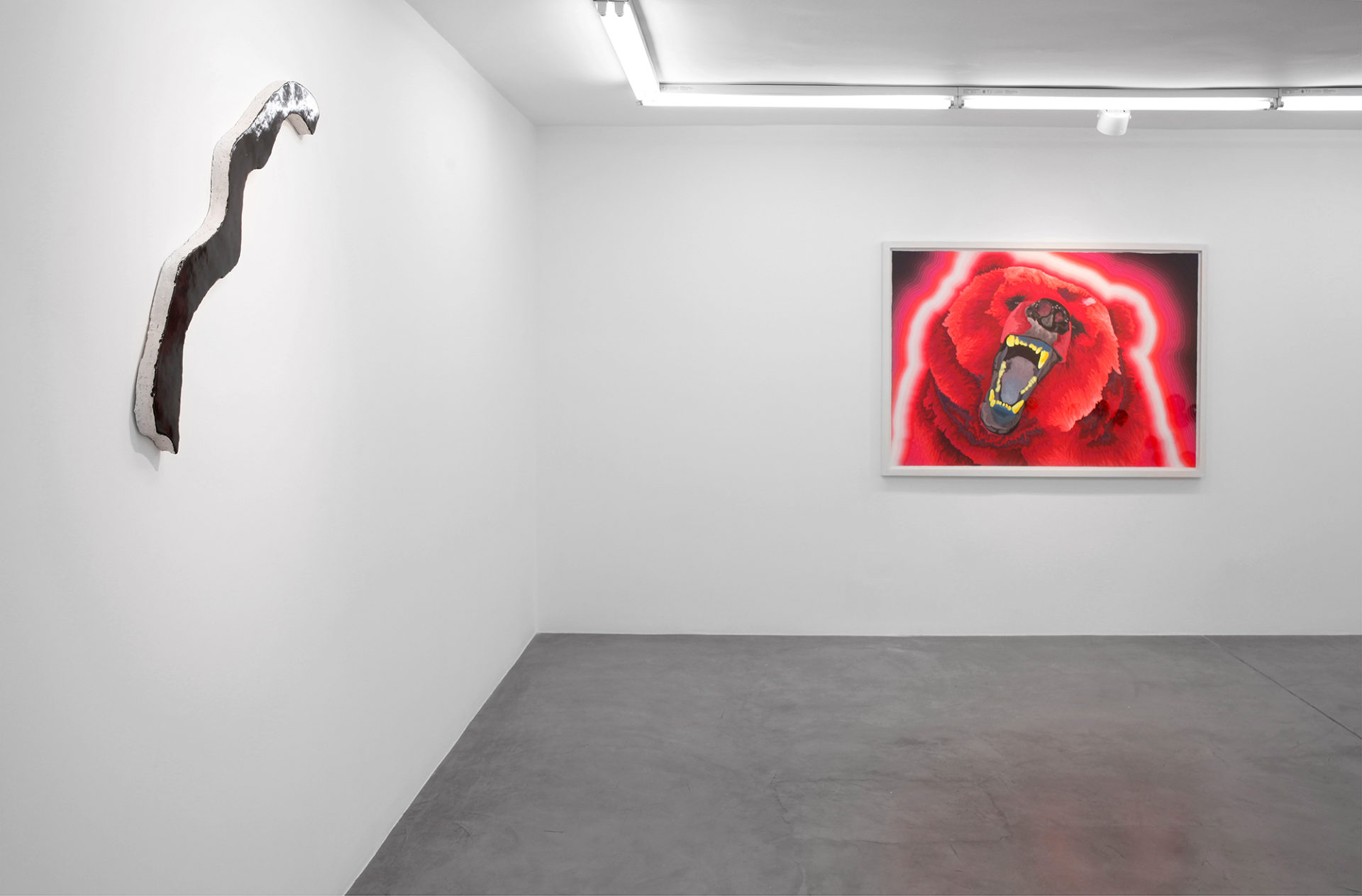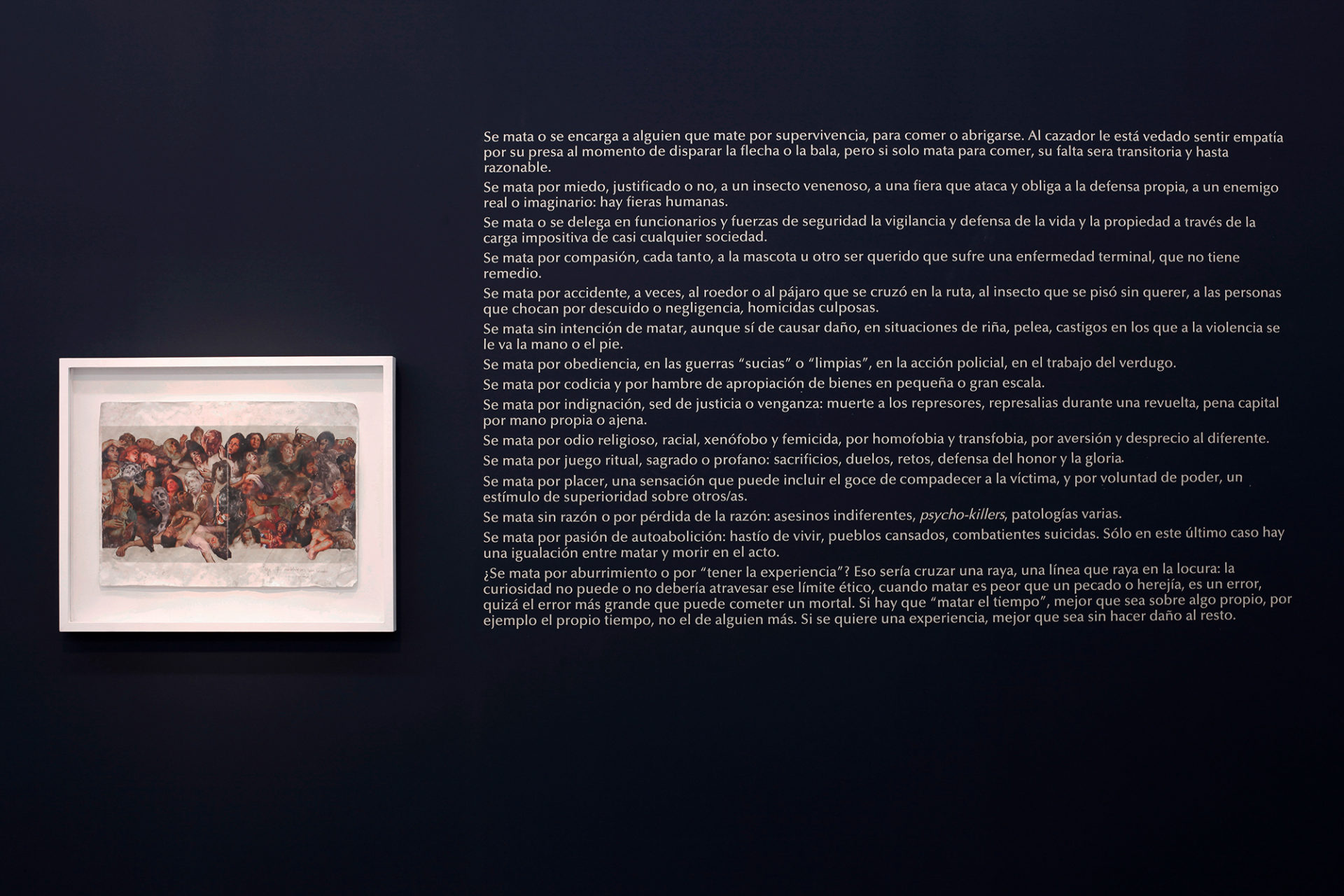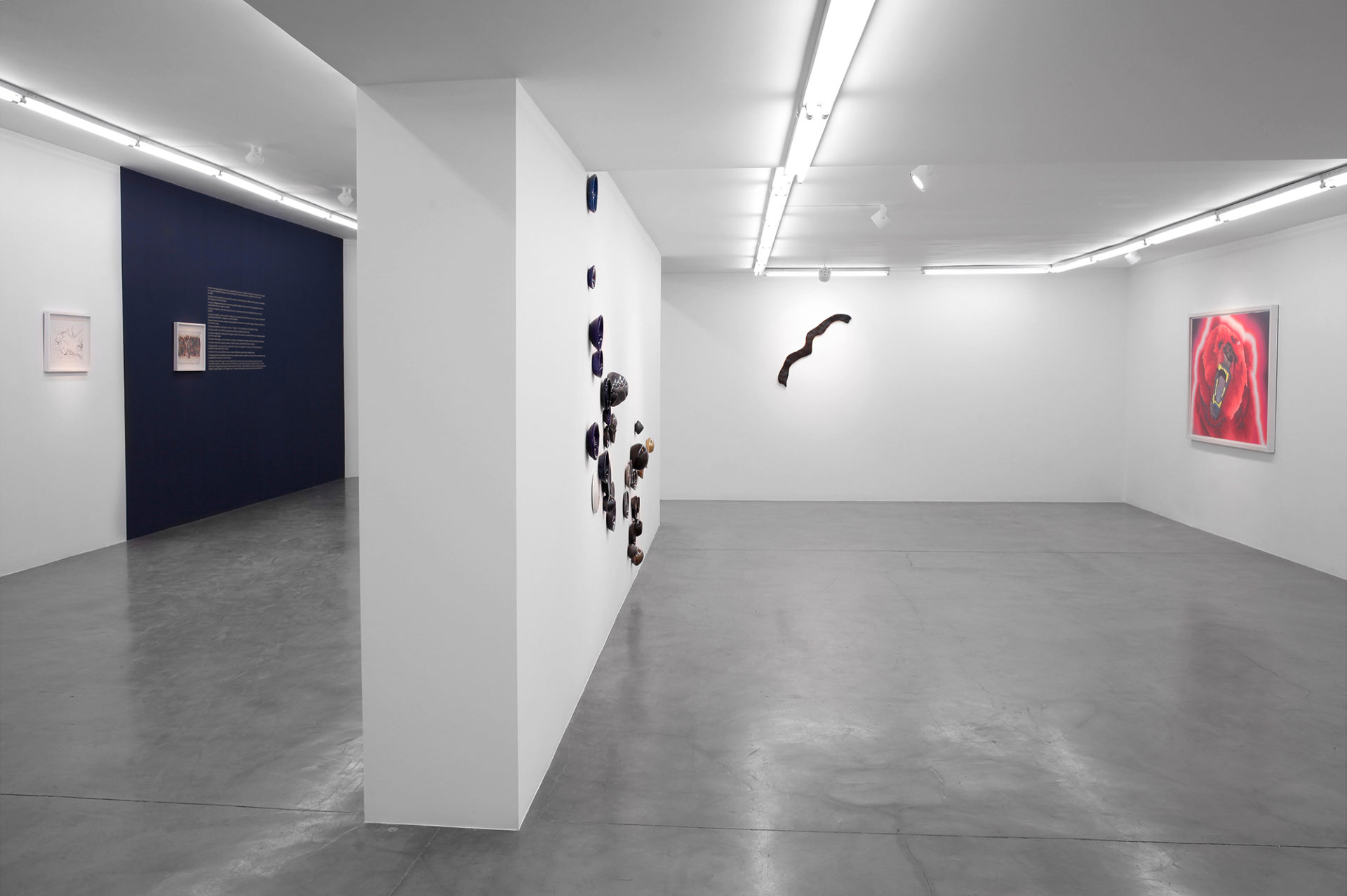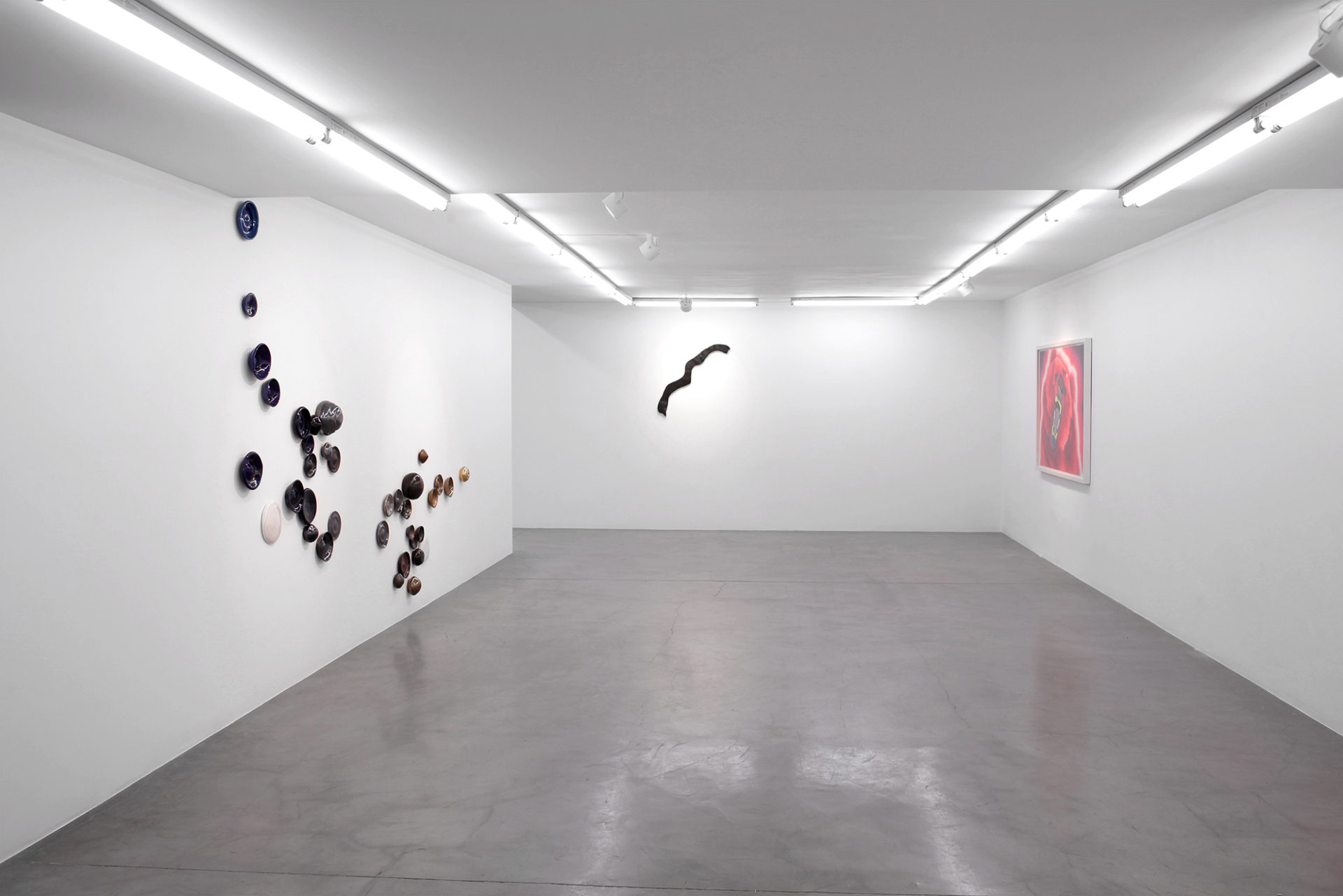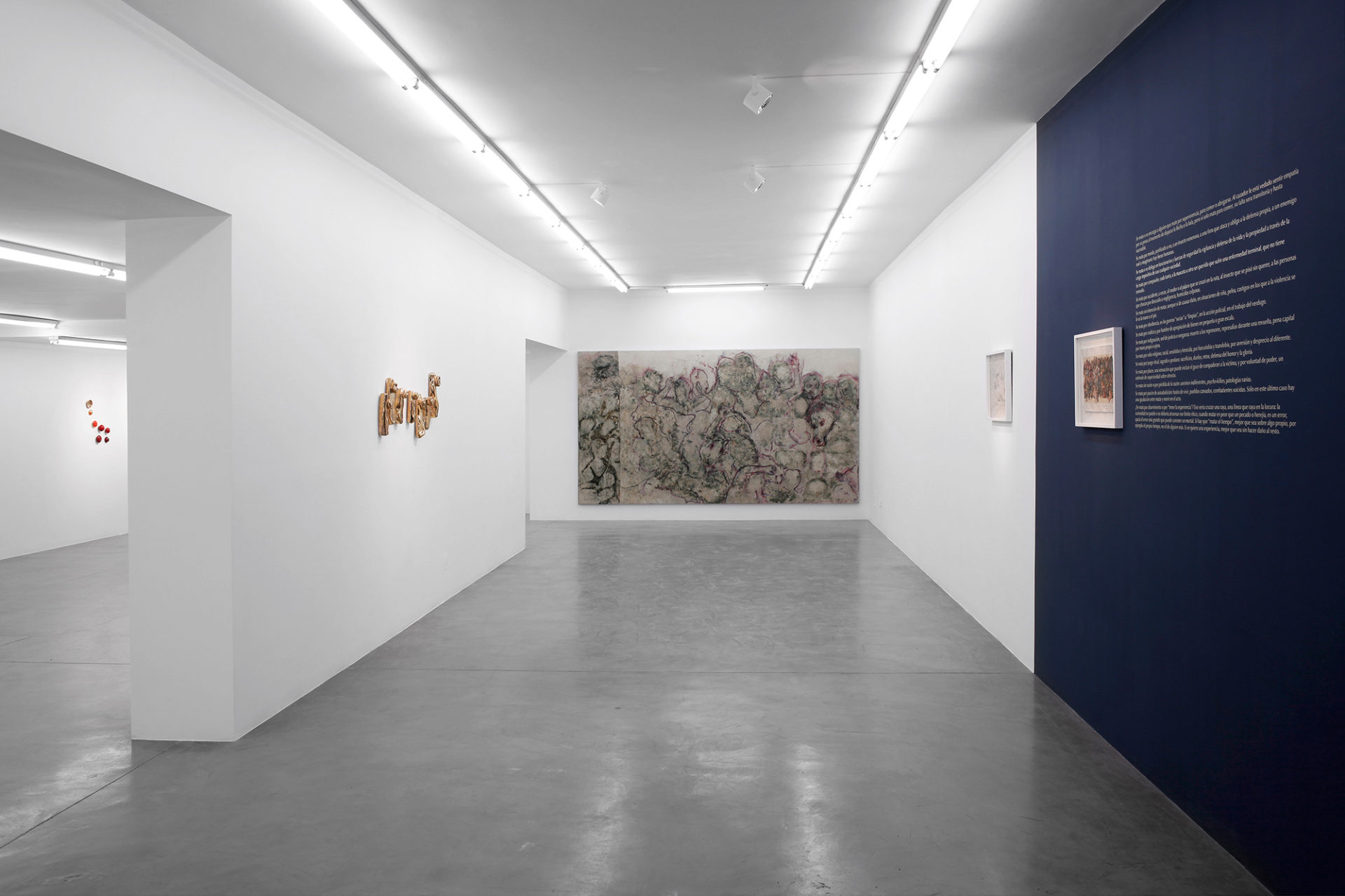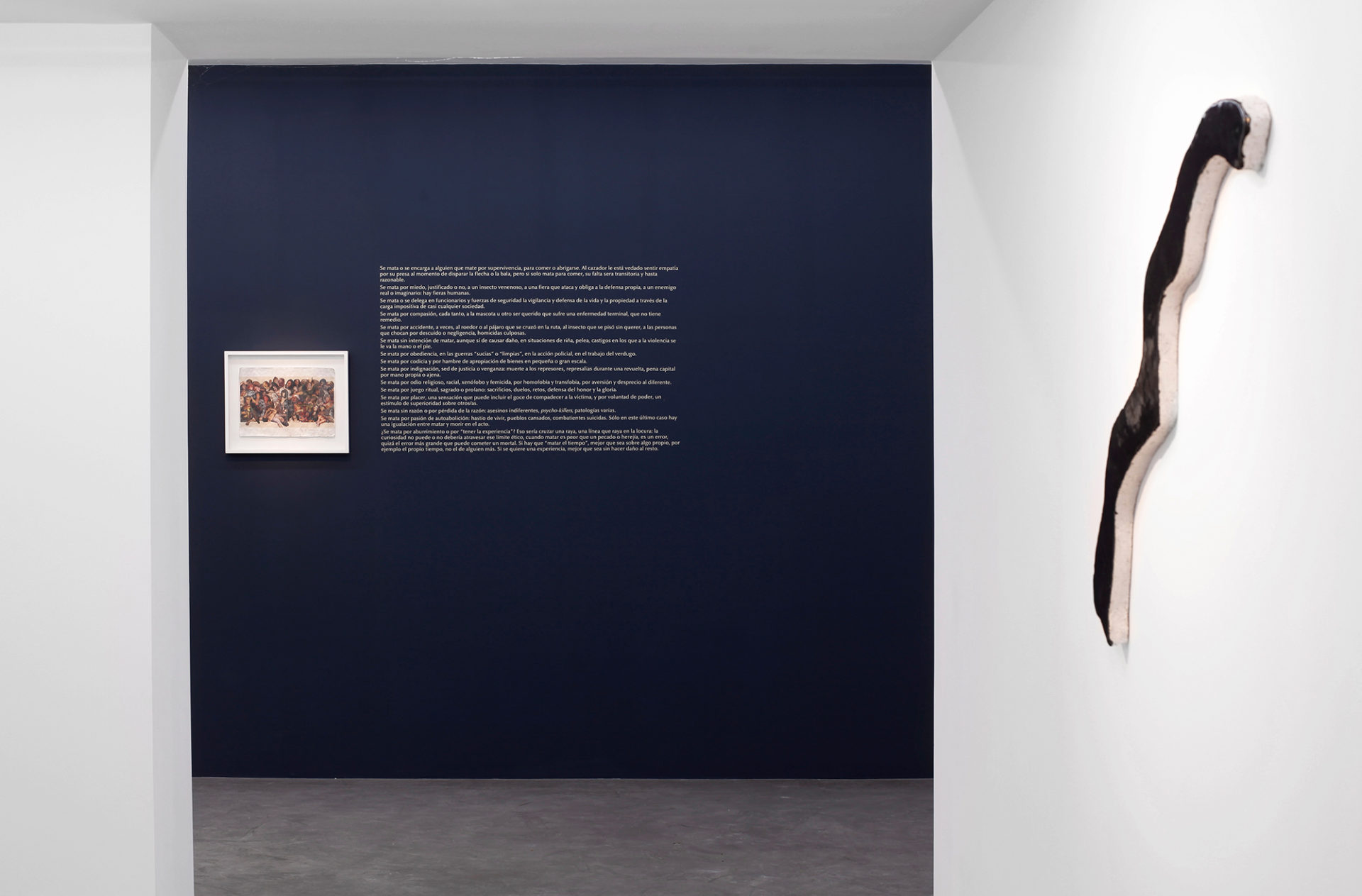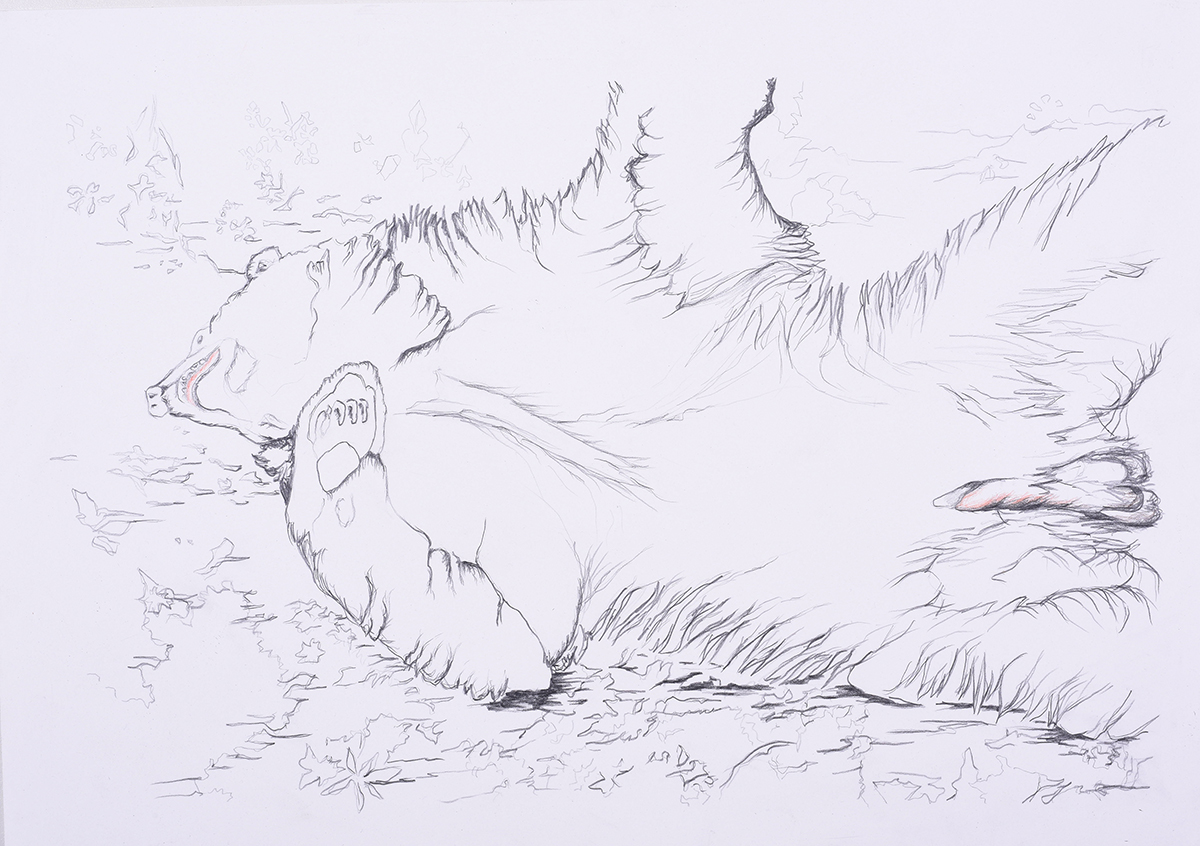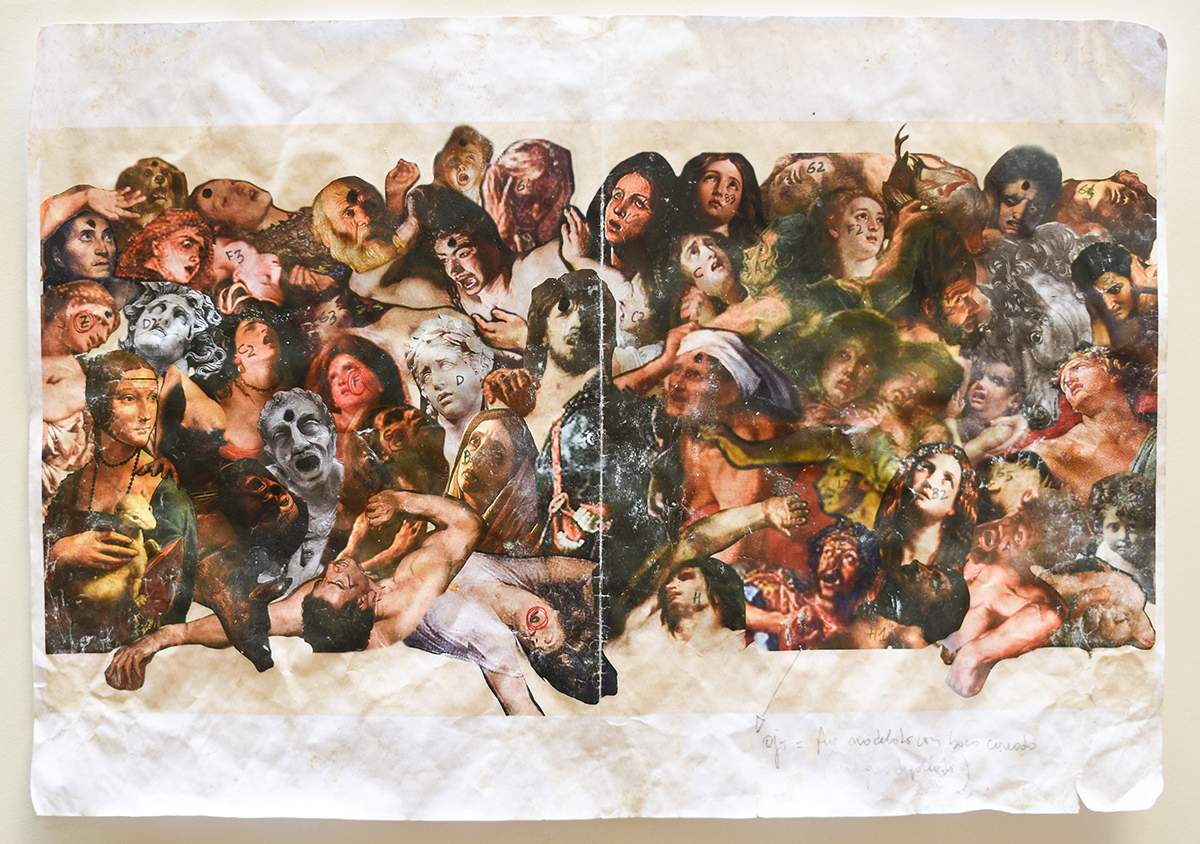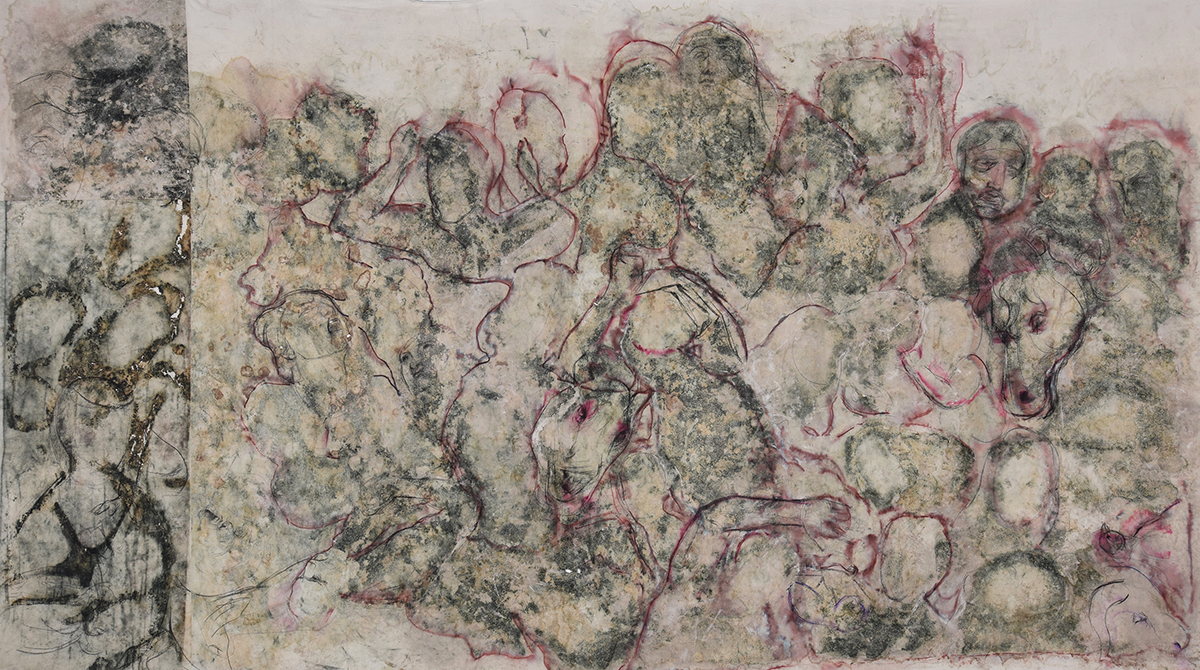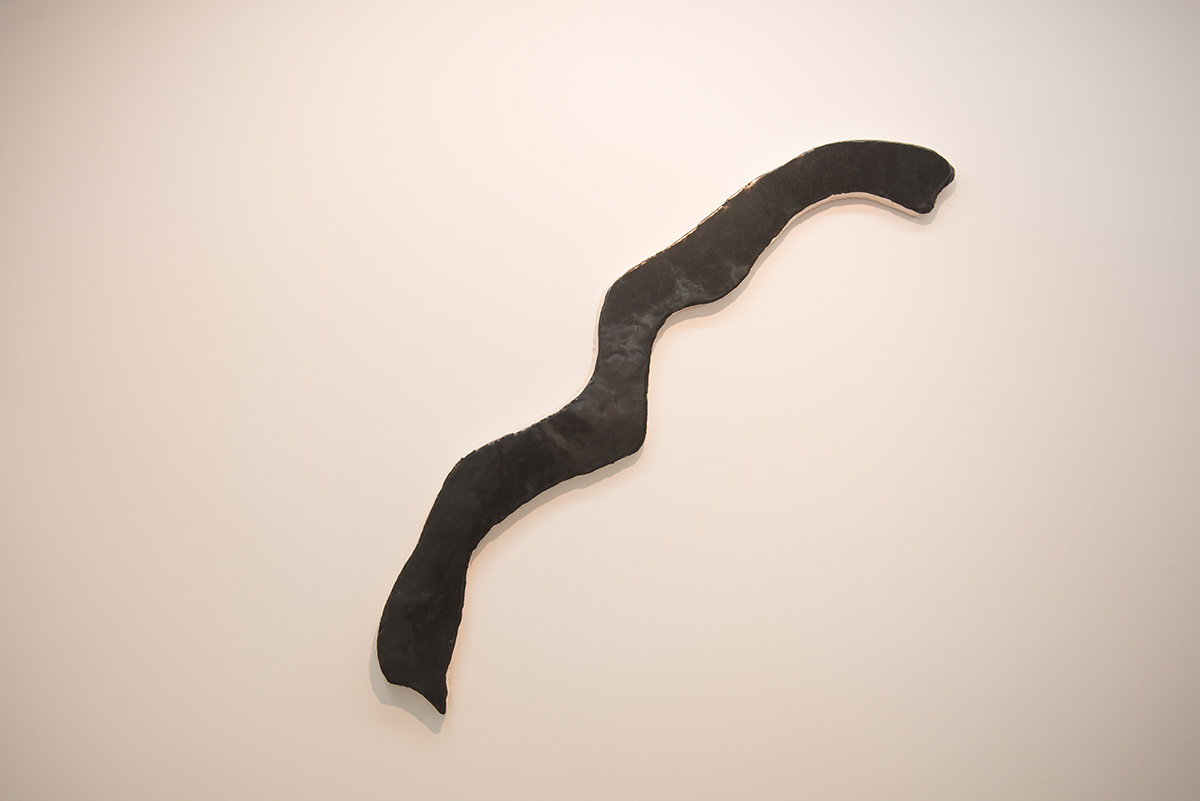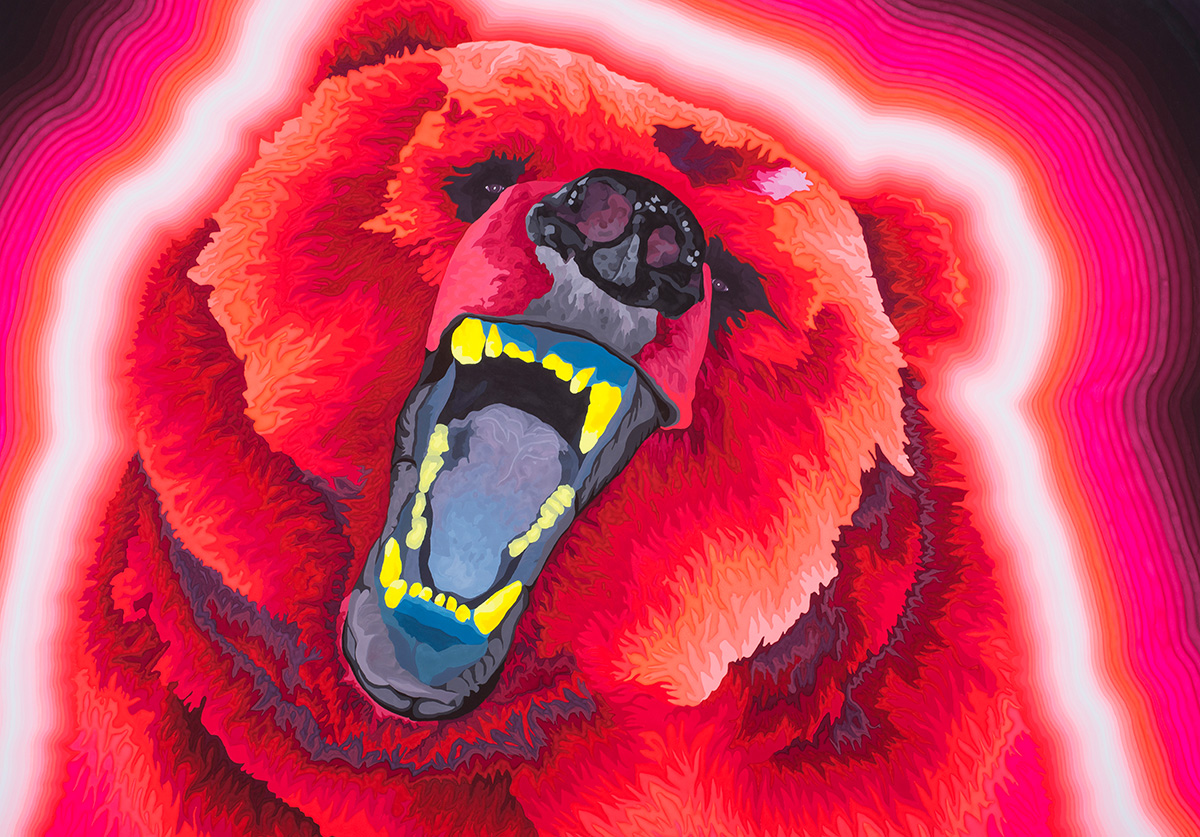MATAR Y MORIR
GABRIEL BAGGIO
MAR 10. — SEP 21. 2020
exhibition view
Ph. Ignacio Iasparra
works
Matar y morir, 2018 – 2019
Gabriel Baggio
Fungus, marker, graphite and charcoal on canvas
78.7 x 141.7 in
Pegasus. Argenta-Buenos Aires. 1979, 2020
Gabriel Baggio
Enameled ceramic with gold and platinum luster
98.4 x 137.8 x 2.8 in
Cruz del sur. Argenta-Buenos Aires. 1979, 2020
Gabriel Baggio
Enameled stoneware with gold luster
59.1 x 51.2 x 2.8 in
Osa mayor, osa menor. Argenta/Buenos Aires. 1979, 2020
Gabriel Baggio
Enameled ceramic with gold luster
39.4 x 59.1 x 2.8 in
TEXT
Return to the Kingdom in One Act
This show summons the acts of killing and dying as expressions of life. And as basic facts of existence. Not to kill or to die—a useless and dangerous binary, apt for any war. Just the opposite: the conjunction and between the verbs to kill/to die was central to the artist inspired for an instant. At that instant when the trigger is pulled, someone dies and someone is born. In two hemispheres, Pegasus of the South and of the North. In different phases, from destruction to creation, from battle to contemplation. From contemplation of battle to creation of what will be destroyed.
The scene where a violent death is met is a secret commonplace and disjunction more ordinary than believed. It is, of course, better not to think about it—it can be unbearable. But it is also, potentially, aesthetic: mangled bodies on the ground under the gaze of the sky might make up a still life—life standing still. Or a dead life. Life enmeshed with death that is part of nature—seemingly still but in motion.
But the Bible says Thou shalt not kill, and not that many years ago Oscar del Barco¹ renewed that commandment in an open letter where he questioned killing for revolution, nation, freedom, or emancipating ideals. He said, “Thou shalt not kill a human being because each human being is sacred and each human being is humanity in its entirety.” And not killing, he went on, is impossible, because we do, in fact, kill-and the only possibility, because if killing were accepted on principle, humanity wouldn’t exist. Not killing would be a plea, a prayer, a commandment with no explanation, hovering around like a presence-less presence, like a force-less force, like a being-less being.
But we do kill—and not only to defend a territory, an ideal, a religion. Thou shalt not kill would, in those cases, be an anthropocentric principle, a characteristic of the species, of humanity. If we extended that commandment beyond the human, not killing would be even less likely. Killing is performed or delegated to butchers and slaughterers, to fishers and cooks, who process the flesh of birds, cows, pigs, sheep, fish, shellfish. When we are not up to killing ourselves, we pay those who know how to do it.
Ahimsa, the first precept of the Pali Canon, rejects violence because everyone fears death: knowing that everyone feels like you, you don’t kill or have killed. It could also be put that others (mortals) are like me, which means it is better not to kill or have killed. It is assumed that all living organisms want to live and fear being killed. Notwithstanding—or for that very reason—we kill.
We kill or have someone kill for us for survival, for food, or for shelter. The hunter must not feel empathy for his prey at the moment he shoots the arrow or bullet, but if he only kills for food, his infraction is transitory, or even reasonable.
Afraid, justifiably or not, we kill a poisonous insect, an attacking beast in self-defense, an enemy whether real or imagined (there are human beasts).
We kill or, in almost any society, pay taxes to have police forces watch over and defend our life and property.
Every so often we kill out of compassion: a pet or someone we love afflicted with a terminal disease.
We sometimes kill by accident: a rodent or a bird crossing the highway, an insect inadvertently trampled on, another person in a collision due to carelessness or neglect in acts of manslaughter.
We kill, not intending to kill but just do harm, in disputes, fights, or punishments where the violence gets out of hand.
We kill out of duty in wars both “dirty” and “clean, in police raids, and as executioners.
We kill out of greed or because we covet, grandly or modestly, things not our own.
We kill out of outrage, thirst for justice or revenge: death to the tyrants who have kept us down, retaliation during an uprising, capital punishment at one’s own hand or another’s.
We kill out of religious or racial hatred, in acts of xenophobia and femicide, homophobia and transphobia, out of aversion to and disdain for the different.
We kill in rites, both sacred and profane: sacrifices and duels to defend honor or glory.
We kill for sport: recreational hunting, bullfighting, animal fights—the modern-day heirs to the gladiators’ circus.
We kill for the pleasure of it, which can even include the pleasure of pitying the victim, and we kill in pursuit of power, to gain mastery over others.
We kill for no reason or because we have lost it: cold-blooded murders, psycho killers, and other afflictions.
We kill in a self-destructive passion: tired of living, peoples worn out, suicide combatants—the only ones who kill and die in a single act.
Do we kill out of boredom, just to experience it? That would mean crossing a line, a line that borders on madness: curiosity cannot or should not lead us across that ethical limit. To kill is worse than sin or heresy, it is a mistake— perhaps the greatest mistake a mortal can make. If we have “to kill time,” better to kill our own time, not someone else’s. If you want an experience, have it without harming others.
At stake are frontiers: violence has an eroticism and its potential is in us. That was Bataille’s battle: to reveal the eroticism even in death, to clamor for consciousness of it. A limit we place on ourselves. Without innocence: the representation of all suffering, all acts of cruelty, all massacres in and for human history will not necessarily keep that impulse at bay. Art here is a weak god. But that does not mean that it ceases to act, to intervene in the animal movement back and forth between to kill and to die.
That movement takes us right back to the kingdom of belonging. We know nothing—at least not in the flesh—of what the experience of violent death feels like in the vegetable kingdom, and that is something we share with animals. It is not, of course, the same: there are obvious differences between killing a human being and a non-human animal, and between killing a vertebrate and an invertebrate. We are more compassionate with those like us, with those closest to us on the evolutionary scale or food chain: mammals, birds, fish. There are also intra-human distinctions and hierarchies that can be justified in different ways. “A murder” is an unlawful killing, a crime according to social structures and customs that change from time to time. Femicide was not a legal concept until the end of the twentieth century. In many places, the execution of an adulteress and “crimes of passion” are not consider illegal, nor is rape and slaughter in combat.
Historian Johan Huizinga established that communities in ancient civilizations set limits on what was permitted in war as part of a culture to which honor was central. The rivals had to know and respect the rules, and respect one another because they were considered equals. But when war is waged on those considered inferior, or outside the species, tribe, or clan, the bounds of violence vanish and all that is left is the desire to defeat by exterminating or humiliating the enemy. Perhaps that is why today we are faced with so many climatic, environmental, and social disasters and emergencies.
Art can do nothing to stave off this holocaust. Art can reveal the cock, the bullet, the body that, when bared, shows us all to be equal. Though we believe that body to belong to someone different, the bare skin of genitals exposed during a ritual sacrifice awakens us to its primordial condition. The sacrificial body reminds us of our lost continuity. We all die. We all kill. To kill is the same as to die: dreadful, and often inevitable.
Exceptions: a tiny portion of humanity does not kill or demand that others do so, or tries not to kill under any circumstances, even hunger. Monks who are not only vegans, but also shake out their chairs before sitting down to make sure they don’t squash any insect whose life also matters. People who are careful not to kill inadvertently or in alleged self-defense any micro-organism we might be able to identify with, because we are living things and part of a continuum that reincarnates and comes apart in myriad forms that are born and die over the course of eons.
There are signals in the firmament, dead suns, corpses of stars that shine down on our eyes after having disappeared light millennia ago. And closer at hand, here down below, the kingdom of fungus. Neither vegetable nor animal, fungi proliferate in the residue left by decaying fabrics, damp bodies, fossils, old walls. A mediating kingdom. Empathy is aroused perhaps by consciousness or perhaps by genes, but it is not available to everyone. It might be a question of reducing as much as possible the harm we can cause as we make our way through that tiny sliver of time-space that separates our birth from our death. Art as a means to minimize damage, or as a form of gratitude, just as the invention of gods was and still is. The promise of mediation between kingdoms whose basic nature has been forgotten, the one that goes from death to life in a single gesture, like a shooting star we have just seen and that, like this split second of convergence, is done as soon as we figure it in our mind.
Osvaldo Baigorria
Buenos Aires, 2020

